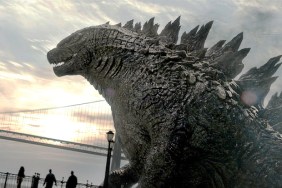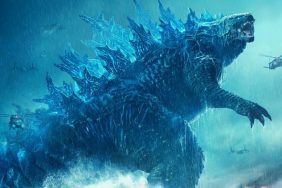When we last left Godzilla, he had just been killed to death by a combination of the huge-ass monster Destroyah and the sudden increase of his own nuclear heat. Destroyah weakened him, and he melted down the rest of the way. Godzilla Junior was left to witness all of this, and the implication was that Godzilla Junior would continue the destructive legacy of Godzilla Senior. Toho, however, decided to end the series, and it would have been a fitting ending too. Godzilla melts down like a badass, and his son wails from the remaining lake of glowing radioactive goop. That film (Godzilla vs. Destroyah) was made in 1995. As we all know, though, the series did not end there, and seven remaining Godzilla films are left to be seen.
In this week’s installment of The Series Project on CraveOnline, I will be stretching nobly into the 7th and penultimate week of my Summer of Godzilla, which has been a daunting, awesome, and totally fun task that is proving easier than I ever expected. As I have remarked in previous weeks, I was afraid that the constant string of monster mayhem would begin to wear on me after a while; that scene after scene of monster-on-monster action would become repetitive after only a short while. I am so glad that this did not prove to be the case. Maybe it’s just the way I’m wired – I do tend to appreciate action movies more if they’re aimed at ten-year-olds than if they’re aimed at 15-year-olds – but I have been able to absorb and enjoy most of the Godzilla films to date with ease, grace, and aplomb. Sure, there have been some duds along the way (I would recommend that you steer far, far afield of All Monsters Attack, easily the worst in the series), and I understand that many may not have the patience to sit through scene after scene of guys in big rubbery monster suits wailing on each other. But this has become by bread and butter. I trust that next week’s installation, which will bring this epic quest to a close, will be a melancholy farewell.
I have also mentioned in previous weeks that the tone from Godzilla to Godzilla has been remarkably similar. There are occasional cautionary tales sprinkled throughout (Godzilla vs. Hedorah and Godzilla vs. Biollante are notable asides), but for the most part, Toho has maintained a fun, cartoonish, insane quality that makes sense in a Saturday morning cartoon sort of way. What better way to defeat Godzilla, for instance, than to go to the future, outfit King Ghidorah with a robot head, and bring it back to the present to do fight? It’s when aliens, robots, time travel, and the like are involved that Godzilla is strongest.
Godzilla is weakest, however, with where we’ll be picking up this week. As I just mentioned, Godzilla died in the previous chapter of the series, and Godzilla was ostensibly over. It was at this point that an American film studio decided to re-up the Godzilla myth in America by making their own version of the Godzilla story using state-of-the-art visual effects, American actors, an American setting, and an all-new version of our hero monster. The result was a $130 million 1998 summer blockbuster called simply Godzilla that most Americans of a certain age remember seeing, and remember loathing. Let’s get to that one we all remember and all love to hate…
Godzilla


Release Date: 20th May 1998
New Monster: Zilla
Description: Lithe, square-jawed iguana fratboy
Origin: An iguana egg was irradiated and hatched after 50 years.
Destruction: Shot by missiles.
Ancillary Monster: 400 BABIES
Actor(s): N/A
So, yeah, we all kind of remember this one. Released in the early summer of 1998, Godzilla was preceded by a year-long fanfare, much speculation, and the imprimatur of its director having made Independence Day, one of the biggest movies of all time (at the time). The film’s advertising slogan was “SIZE DOES MATTER,” and a $600,000 teaser featured the G-Man’s foot crashing through the roof of a museum to stomp on a Tyrannosaur skeleton. While the name Godzilla was used, clearly this was an attempt to outdo the dinosaur mayhem of Jurassic Park from five years previous. There was a hit soundtrack record, even. This was America’s chance to take a giant monster who had only been famous in Japan, and make it HUGE.
The result was, well, notoriously awful. Critics and audiences hated it, and it’s often pointed to as one of the worse summer blockbusters, and has been used as a prime example of how glut on spectacle can ruin a perfectly decent summer movie. The film doesn’t feel anything like a Godzilla movie, and more like the usual globe-trotting multi-culti disaster/comedy we have come to expect from director Emmerich. None of the fun is there, and even the destruction seems to be on a smaller scale. In previous films, we had seen Godzilla stomping down on entire buildings. This Godzilla is much smaller, is able to burrow into subway tunnels, hide inside skyscrapers, and manages to evade detection for long, long stretches of the movie.

Which is where the main problem comes in: Not enough Godzilla. Godzilla 1998 is the longest of all the Godzilla movies at a bulky 138 minutes, and the vast bulk of that running time is devoted to the start-and-stop romance between Dr. Niko Tatopoulos (Matthew Broderick) and his onetime college sweetheart Audrey (Maria Pitillo) who dreams of becoming a star reporter someday. We also have subplots with other potential love interests, an underground French military complex run by Jean Reno, an ineffectual military, a goofy New York mayor named Ebert with a sniveling sidekick named Gene (tee hee, Emmerich hates Siskel and Ebert), a trash-talking cameraman (Hank Azaria), and a 35-minute scene wherein our heroes run around Madison Square Garden eluding baby Zillas. About 100 minutes into this film, you’ll see a scene where Audrey is weeping on a bed, wondering why she stole a top secret videotape from her ex-boyfriend, and asking Hank Azaria if she’s a bad person – all while a 50-foot iguana is loose in New York. Excuse me, but if you’re going to make a Godzilla movie, perhaps you should, y’know, put your monster in it more.
What’s more, the humor in the film is painfully clunky. Every conversation, every aside, every character seems less suited to an action film, and more to a straightforward New York comedy. Every other line is a wisecrack, and many scenarios are meant to be comedic. Waiting 30-45 minutes for the monster to show up is bad enough, but when that time is spent with wise-cracking romcom types talking about their lost loved, it’s downright insufferable. This film is worse than you remember it being.

Despite the huge budget, maybe there wasn’t enough money to do what they wanted. Godzilla, or rather Zilla, is constructed almost entirely through CGI in this film, and there are many wholly animated digital scenes, which was not yet the norm in 1998. As such, this Zilla creature, which looks largely like an iguana with a big lower jaw and lithe legs, comes across as impersonal and more animal than Godzilla has been previously. I have always seen Godzilla as having at least something of a personality. This Godzilla is more like a vermin that must we wiped out. Had this film been made in Japan, they would have done something fun with the New York location, like mutate the local rats and/or roaches to do battle with Zilla. No such luck. It’s just a matter of tracking it down and killing it with missiles. The script refers to Zilla as “he,” but we all know it’s an “it.”
And, yes, Zilla lays a bunch of eggs, which all hatch, and New York is almost overrun with hundreds of baby Zillas. Luckily they blow up Madison Square Garden (the Zilla nest) just in time. The Zillas will remind you of the velociraptors in Jurassic Park in the way they look, they way they move, and the way the filmmakers exploit them. This is not a Godzilla pastiche, but a Jurassic Park ripoff. The film ends with our heroes tangling Zilla up in the cables of the Brooklyn Bridge, and the military shooting it to death. There is no cautionary tale about the creature’s nuclear origins, no tragedy, and no thrills.

Why “Zilla?” Well, according to Toho, this particular creature is most certainly not Godzilla. They call it Godzilla in the film (and there’s a cute homage to the notorious American mispronunciation of “Gojira”), but it is not Godzilla. This is, according to the 2001 film Godzilla, Mothra, and King Ghidorah: Giant Monster All-Out Attack, a smaller creature that Americans assumed was Godzilla, but wasn’t. This was actually just a giant lizard named Zilla. Zilla and Godzilla will appear on screen together in the final Godzilla film, and Zilla will be hastily trashed. Even Toho sees this film as a joke, and they were behind Biollante, Gigan, and Megalon.
Odd that the slogan of the film should be “SIZE DOES MATTER,” and then give us what is actually the smallest of all the Godzillas. Godzilla has been increasing in size as the series has progressed. Now he’s pretty tiny. Only about four stories tall. If size matters, then this Godzilla doesn’t. He also uses a breath weapon only twice, and even then it’s kind of like a combustible gasoline breath rather than the big radioactive blasts seen previously. It should come as mo surprise that the director of this film hates Godzilla movies.
I have seen this movie twice in the course of a week, and recorded an upcoming commentary track for it as part of the Sofa Dogs podcast. Listen to it if you want this film to be made tolerable. Godzilla 1998 was so lathed by the world at large, that I think it was the motivating factor behind Toho’s reboot of the series, which was released in American theaters not two years later, and five years after the last Japanese Godzilla. Let’s take a look at…







